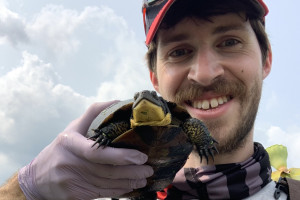Research and Recovery: Jesse Sockman '17 is knee-deep in amphibian and reptile conservation research
In his daily work as a conservation researcher, Sockman's primary goal is to leave Ohio species better than where he found them. Still early in his career, his legacy is bound to embody his love for wildlife and his desire for others to know that conservation succeeds when people care enough to unite and act.

After graduating from Malone with a B.A. in Zoo and Wildlife Biology, Sockman obtained his M.S. in Biological Sciences from Eastern Kentucky University. Learning from his mentors and honing their teachings, Sockman is now an amphibian and reptile conservation researcher at the Ohio Biodiversity Conservation Partnership, a partnership of the Ohio State University and the Ohio Division of Wildlife.
“As an amphibian and reptile conservation researcher, my role is to facilitate the conservation and recovery of Ohio’s threatened and endangered amphibian and reptile species through research, direct conservation action, and collaborating with other researchers,” said Sockman. “My role at Ohio State has allowed me to participate in education outreach through speaking engagements taking on the role as co-lead for the Outreach and Communications Task Team of Midwest Partners in Amphibian and Reptile Conservation. Not all conservation occurs in the field working directly with wildlife, as a good portion of my time is spent performing statistical analysis and reporting on data we collected. This allows us to make informed management/conservation action suggestions and guide future research. All research that I perform is under proper local, state, and federal permits with strict adherence to protocols.”
Brick by brick, Sockman’s research of endangered species plays a factor in developing solutions to save these animals. He and his team work diligently to understand ideas such as environmental, human development, and other threats to a species that challenge long-term viability. Once threats are determined, the road to recovery begins.
“One of our exciting recovery programs is our Eastern Hellbender head-start program,” said Sockman. “These salamanders require clear, quick moving, cool rivers/streams making them indicators of healthy waterways; however, the loss of forest along rivers and other threats have impacted their viability long-term. This is where the head-start program helps.”
The program is a collaboration led by the Ohio Hellbender Partnership which includes universities, environmental organizations, governmental organizations, and several Ohio zoos and aquariums.
“Since I joined the program, I’ve had the privilege of collecting eggs and later releasing juvenile hellbenders back into their environment while monitoring populations statewide with my supervisor. Last year marked an exciting milestone in Ohio. For the first time, a zoo-raised hellbender was found in the wild with his clutch of eggs signifying that he not only survived and grew since release, but successfully reproduced in the wild!”
Like the skills needed to foster the care for wildlife, Sockman is no stranger to stepping into leadership roles and taking action. As a student at Malone, he was a resident assistant, and assistant resident director in Haviland Hall. When he wasn’t focused on his studies, Sockman spent his time in the Malone Zoo caring for the animals and making memories with his classmates and professors.
“I remember the words of Dr. Courter detailing stewardship using two Hebrew words ‘abad’ meaning to serve—meet the needs of a garden so it will persist and flourish and ‘shamar’ meaning to keep—in a loving, caring, and sustaining manner like a parent. Today, that seems to define how I strive to conserve wildlife. Secondly, Kristen Beck reminded me that, when working with animals, ‘you can never know what is abnormal until you know what is normal.’ This phrase spurred me to always invest in understanding wildlife from life history to individual behavior.”
This wisdom from Sockman’s professors and the mentorship he experienced from others on campus, has shaped who he is today.
“When I think about my time at Malone, there is no more defining word than ‘community,'” he said. “Whether it was the support of professors to develop research projects, the residence life team encouraging personal growth, or an upperclassmen group willing to teach a young Zoo and Wildlife Biology student the ropes in the on-campus Malone Zoo; it was people investing in others that set my Malone experience apart. Thinking about my friends and classmates, I made incredible friends at Malone who have transformed into a support system that celebrates and motivates where I am now in my career.”
